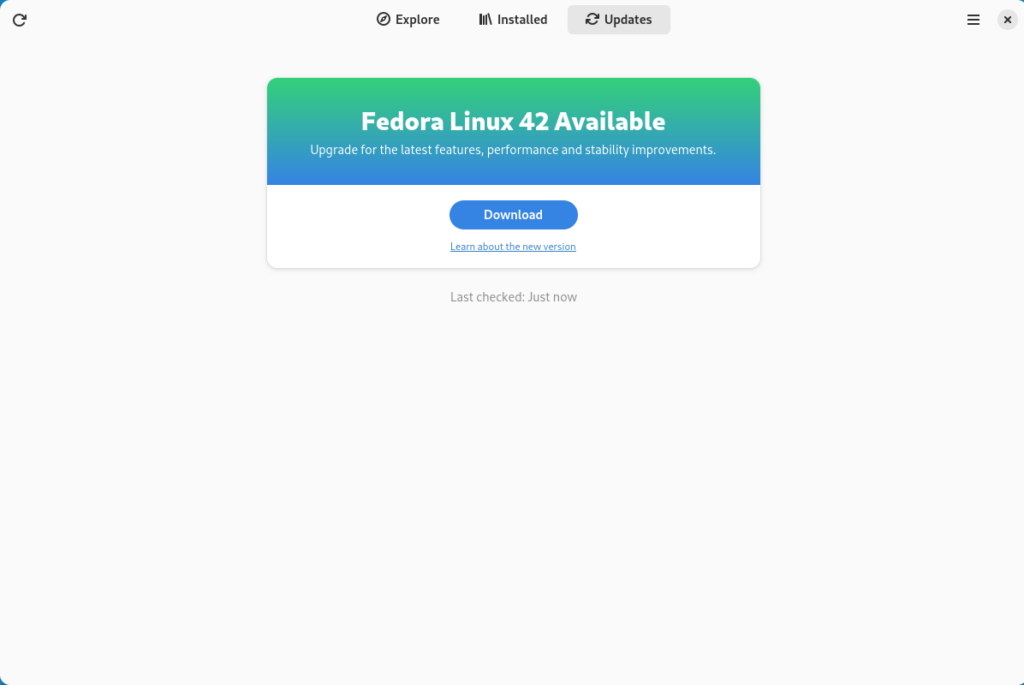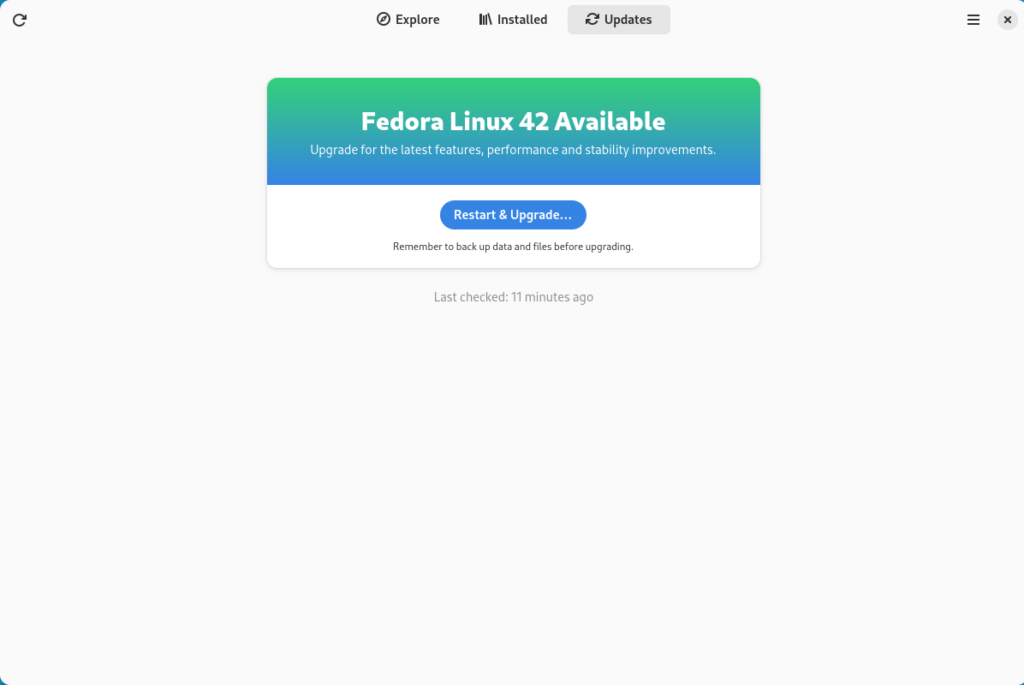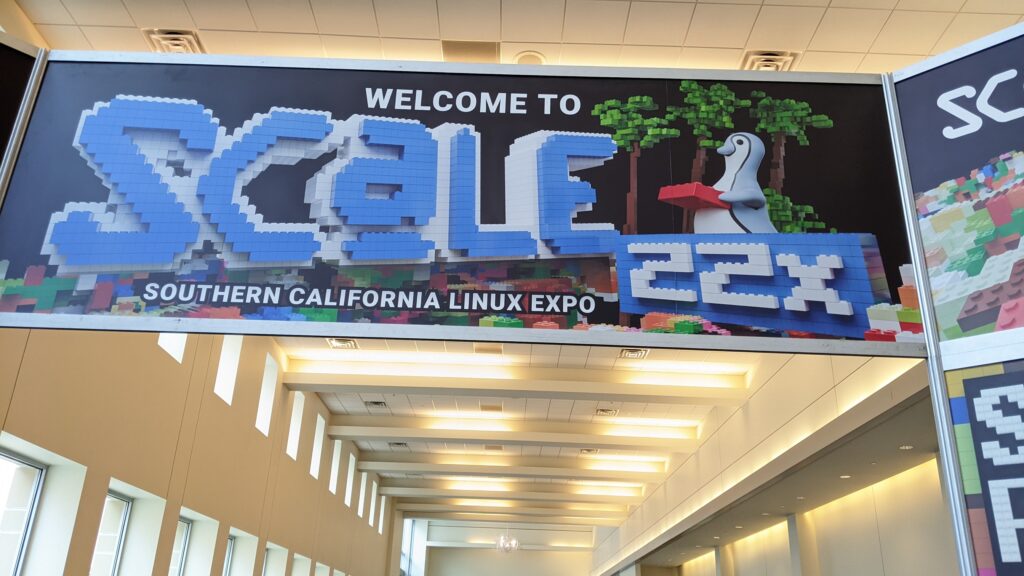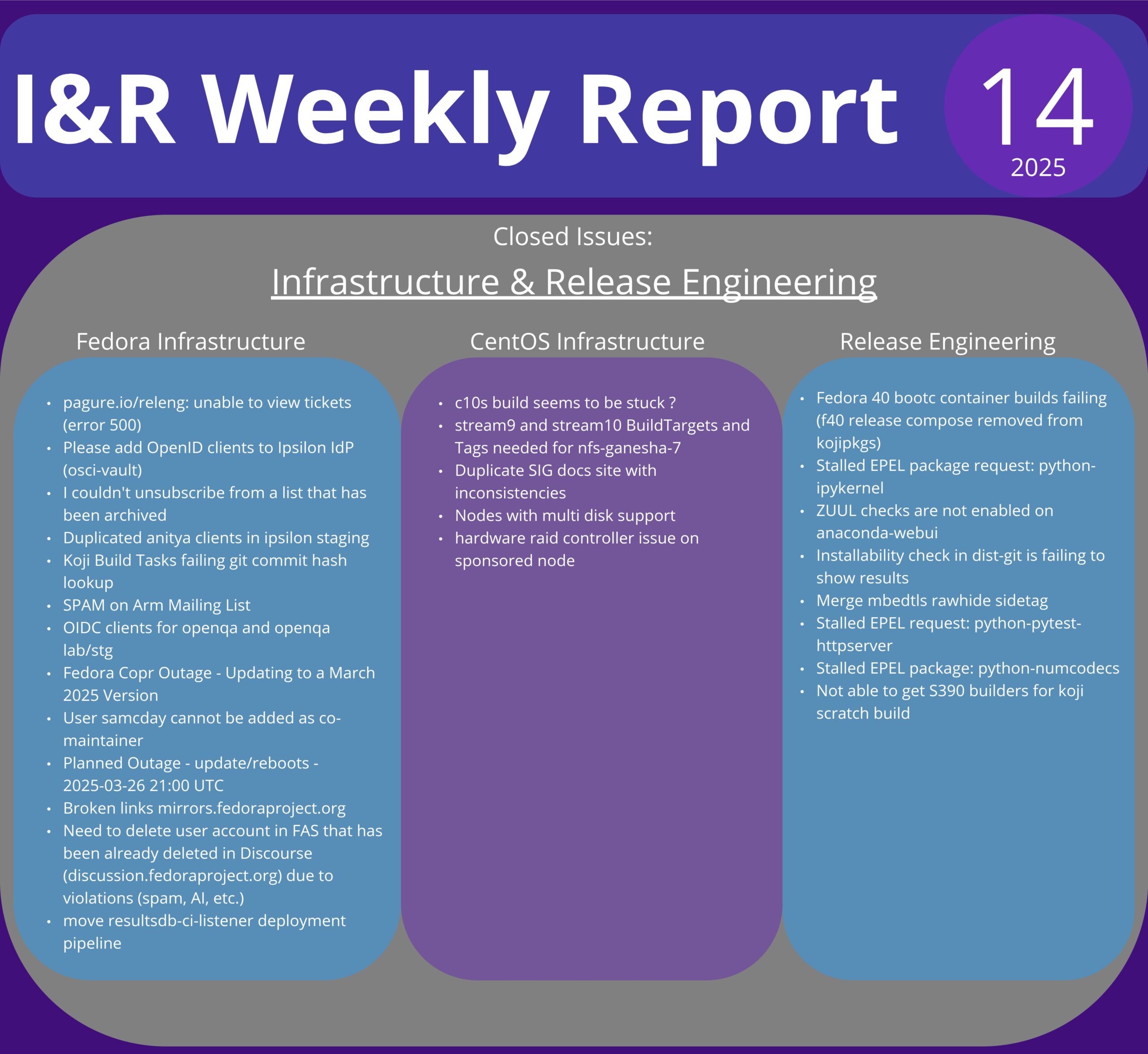This is a weekly report from the I&R (Infrastructure & Release Engineering) Team. We provide you both infographic and text version of the weekly report. If you just want to quickly look at what we did, just look at the infographic. If you are interested in more in depth details look below the infographic.
Week: 21st – 25th April 2025

Infrastructure & Release Engineering
The purpose of this team is to take care of day to day business regarding CentOS and Fedora Infrastructure and Fedora release engineering work.
It’s responsible for services running in Fedora and CentOS infrastructure and preparing things for the new Fedora release (mirrors, mass branching, new namespaces etc.).
List of planned/in-progress issues
Fedora Infra
- In progress:
- FedoraQA – Testdays – OIDC setup
- Find old docs content on proxies and remove it
- redeploy aws proxies
- Disable self-serve project creation on pagure.io
- Link in staging distgit instance leads to prod auth
- re-add datagrepper nagios checks (and add to zabbix?)
- Fix logrotate on kojipkgs01/02
- 2025 datacenter move (IAD2->RDU3)
- Broken link for STG IPA CA certificate, needed for staging CentOS Koji cert
- [CommOps] Open Data Hub on Communishift
- retire easyfix
- Deploy Element Server Suite operator in staging
- Pagure returns error 500 trying to open a PR on https://src.fedoraproject.org/rpms/python-setuptools-gettext
- Create a POC integration in Konflux for fedora-infra/webhook-to-fedora-messaging
- maubot-meetings bot multi line paste is cut
- setup ipa02.stg and ipa03.stg again as replicas
- Move OpenShift apps from deploymentconfig to deployment
- The process to update the OpenH264 repos is broken
- httpd 2.4.61 causing issue in fedora infrastructure
- Support allocation dedicated hosts for Testing Farm
- EPEL minor version archive repos in MirrorManager
- Add fedora-l10n pagure group as an admin to the fedora-l10n-docs namespace projects
- vmhost-x86-copr01.rdu-cc.fedoraproject.org DOWN
- Add yselkowitz to list to notify when ELN builds fail
- Cleaning script for communishift
- Move from iptables to firewalld
- Port apps to OIDC
- Help me move my discourse bots to production?
- Replace Nagios with Zabbix in Fedora Infrastructure
- Migration of registry.fedoraproject.org to quay.io
- Done:
- Fedora + EPEL Mirror Request – mirror.maeen.sa
- Inat Box APP
- upgrade to Fedora 42 can use wifi
- DNS BL spam.dnsbl.anonmails.de has bastion on it’s blacklist
- heavy load on koji Sat, 19 Apr 2025 16:12:01 +0200
- Please add new clients + queues to RabbitMQ for osci.
- Secrets storage: Blockerbugs stg bz api key
- Fork failed
- Status code: 403 for https://fedoraproject-updates-archive.fedoraproject.org
- koji build that is in a bad signing state
- Manage our new testing.farm domain via AWS Route53
- Setup RISC-V builder(s) VM in Fedora Infrastructure
- rhel9 adoption
CentOS Infra including CentOS CI
- In progress:
- Release Improvements
- Reconcile duffy DB and AWS EC2 instance
- Write a script to cleanup Duffy DB after retiring a pool
- Please upgrade CBS Koji to 1.35+ for kiwi plugin enhancements
- Add proposed-updates c9s and c10s tags to hyperscale9s and hyperscale10s tags
- Missing s390x extras/extras-common repo
- Ensuring ansible automation in place can manage/control el10 nodes
- [spike] : investigating ppc64le kvm host option with el9/el10 (for Power10)
- (Cloud SIG) OKDerator CI/CD space
- [spike] : investigating needed deps (poetry) for duffy on el9
- Decommission ppc64le duffy nodes in CI infra/env
- [spike] : investigating options/alternatives for the upcoming DC move
- Done:
Release Engineering
- In progress:
- Unretire gtranslator
- F42 Post Release Cleanup
- Fix OpenH264 tagging issues
- Turn EPEL minor branching scripts into playbooks
- Mass retirement of packages with uninitialized rawhide branch
- Please send openh264-2.6.0 to Cisco
- 300+ F42FTBFS bugzillas block the F41FTBFS tracker
- Packages that have not been rebuilt in a while or ever
- Send compose reports to a to-be-created separate ML
- Could we have fedoraproject-updates-archive.fedoraproject.org for Rawhide?
- Investigate and untag packages that failed gating but were merged in via mass rebuild
- a few mass rebuild bumps failed to git push – script should retry or error
- Package retirements are broken in rawhide
- Update pungi filters
- Implement checks on package retirements
- Untag containers-common-0.57.1-6.fc40
- Provide stable names for images
- Packages that fail to build SRPM are not reported during the mass rebuild bugzillas
- When orphaning packages, keep the original owner as co-maintainer
- Create an ansible playbook to do the mass-branching
- RFE: Integration of Anitya to Packager Workflow
- Fix tokens for ftbfs_weekly_reminder. script
- Update bootloader components assignee to “Bootloader Engineering Team”for Improved collaboration
- Done:
- Request for permissions to access bodhi server
- Stalled EPEL package: a2jmidid
- Fedora WSL images for F42 are being composed with F43 content
- Orphan kdissert, flowcanvas
- Remove manually created f41/f42 branches from getmail6 repository
- Remove v4.3.0 and versionbump branches from pgcli repository
- Unretire vim-awesome-colorschemes
- Please rescue partially-initialized repo rpms/tlfloat from releng-bot
- Remove the files for getmail
- Unretire rust-arraydeque
- Unretire rust-migrations_internals
- Missing ostree stable ref for Kinoite 42 on aarch64
- Stalled EPEL package: python-text-unidecode
- Stalled EPEL package: python-grpcio-gcp
- Stalled EPEL package: python-google-api-core
- Unretire rust-ar
- Stalled EPEL package: python-respx
- Stalled EPEL package: python-graphql-core
- Stalled EPEL package: python-parse
- Unorphan getmail
- Unretire rpms/drawing
- Accidentally created a branch in `rust-tonic-types`
- fedora-toolbox missing f42 tag, and testing still points to f38
- .sqlite metadata missing in f41-updates and f41-updates-testing repositories
- F42 Self-Contained Change: Fedora COSMIC spin
List of new releases of apps maintained by I&R Team
- Patch update of Sigul from sigul-0.100 to sigul-0.100 on 2025-04-22
- Patch update of Fedora Messaging from 3.7.0 to 3.7.1 on 2025-04-22
- Patch update of Sigul from sigul-0.100 to sigul-0.100 on 2025-04-21
If you have any questions or feedback, please respond to this report or contact us on #redhat-cpe channel on matrix.
The post Infra and RelEng Update – Week 17 appeared first on Fedora Community Blog.




 F43 is well underway with some changes proposed, and some accepted already. Below are the changes currently up for discussion in our community:
F43 is well underway with some changes proposed, and some accepted already. Below are the changes currently up for discussion in our community:

 So let’s see what arrives with the new releases for the Fedora Atomic Desktops variants (Silverblue, Kinoite, Sway Atomic and Budgie Atomic).
So let’s see what arrives with the new releases for the Fedora Atomic Desktops variants (Silverblue, Kinoite, Sway Atomic and Budgie Atomic).


































 June 21, 2025: Online workshop looking at documentation in Fedora. A planning guide is already
June 21, 2025: Online workshop looking at documentation in Fedora. A planning guide is already  Regular Fedora meetup in Nairobi, Kenya to track contributions and continue the momentum.
Regular Fedora meetup in Nairobi, Kenya to track contributions and continue the momentum.